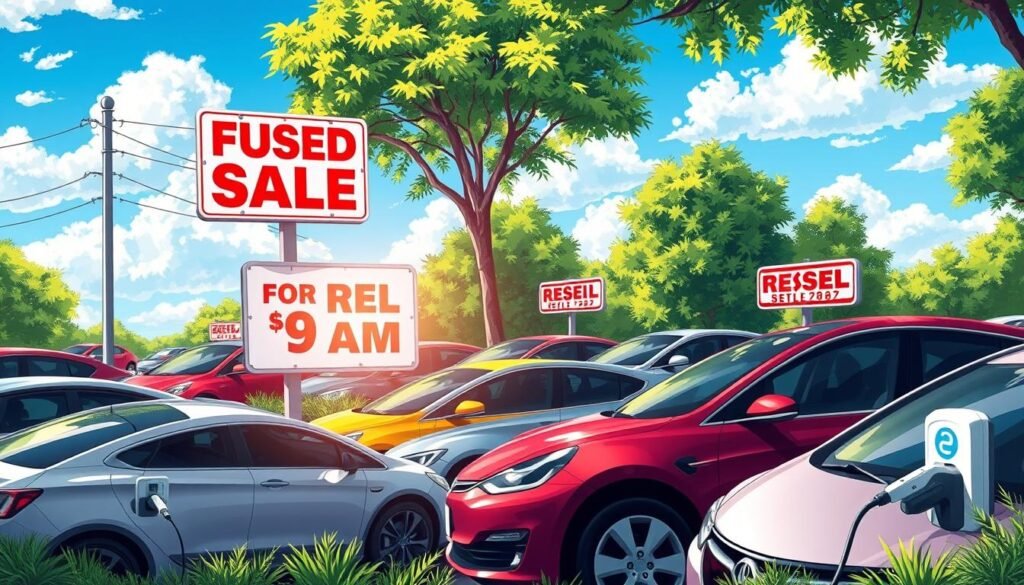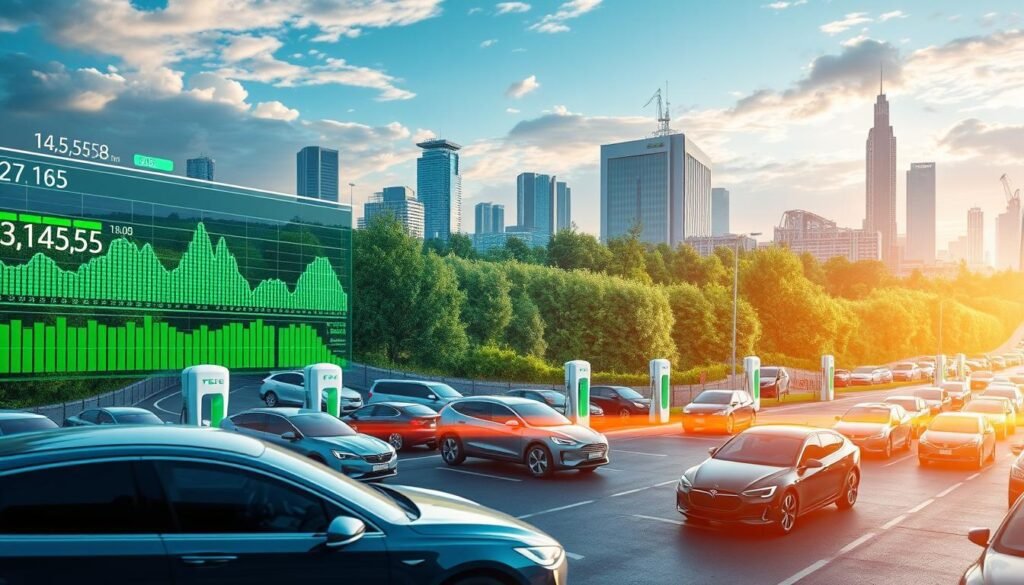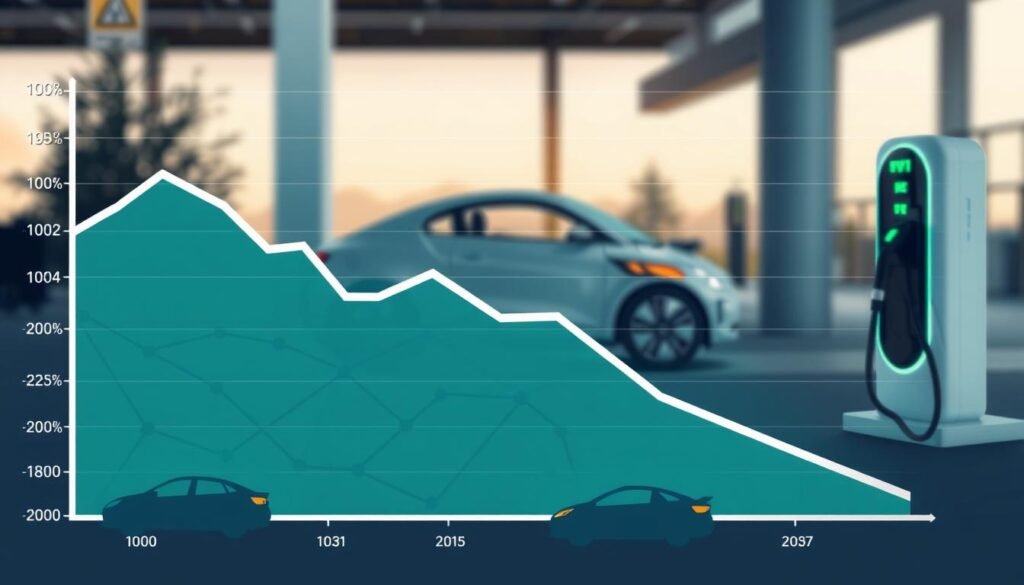A new study reveals that plummeting used values could slow EV take-up further, claims new report. Learn how declining resale prices impact electric vehicle adoption in the US market
A recent study found that falling resale values of electric vehicles (EVs) might slow their adoption in the U.S. As EV prices drop, the used EV market has seen a big price fall. This could hurt consumer confidence and slow the EV industry’s growth.

Table of Contents
Key Takeaways
- The used EV market has experienced a significant decline in prices, indicating rising depreciation rates.
- Regional variations in the used EV market suggest that certain areas may be more impacted by the price drop.
- Declining resale values could undermine consumer confidence and slow the adoption of EVs in the long run.
- Automakers and policymakers may need to address the issue of used EV values to maintain the momentum of the EV transition.
- Strategies to improve long-term value retention could be crucial for current and future EV owners.
Understanding the Current EV Market Landscape
The electric vehicle (EV) market has changed a lot in recent years. Trends and dynamics have shifted, affecting how people buy and use EVs. Let’s look at some key indicators, price changes in used EVs, and how the market varies across the U.S.
Key Market Indicators and Trends
Several trends are shaping the EV industry. EV sales are going up thanks to better batteries, more charging spots, and more people knowing about them. New EV models from big and small companies are also making the market more varied, appealing to more buyers.
Recent Price Fluctuations in the Used EV Sector
Used EV prices have seen some ups and downs lately. Prices have generally gone down, but the speed and size of this drop vary. It’s important to understand these changes for both buyers and the industry as the EV market keeps evolving.
Regional Market Variations
EV adoption rates differ across the U.S. Some areas, like California, have more EV owners due to local perks, charging spots, and green awareness. Looking at these regional trends helps us see what drives EV growth and what challenges it faces in different places.
| Region | EV Adoption Rate | Average Used EV Price |
|---|---|---|
| California | 25.5% | $31,500 |
| New York | 8.2% | $27,800 |
| Texas | 6.3% | $29,100 |
| Florida | 4.9% | $28,400 |

By studying the EV market today, we can learn a lot. We see trends, price changes, and regional differences that shape the industry. This knowledge helps both buyers and the industry make better choices, pushing EVs forward.
Primary Factors Driving the Decline in Used EV Values
The value of used electric vehicles (EVs) is dropping due to several key factors. These factors are changing the market. It’s important to know what’s behind the drop in value of pre-owned electric cars.
The fast battery technology advancements are a big reason. Newer batteries are better and more efficient. This makes older EVs seem less valuable. People want the latest EVs for their better range and performance.
Government incentives also play a big part. Changes in tax credits and rebates affect used EV values. People think about the savings of newer models when buying used.
- Advancements in battery technology, leading to increased range and efficiency
- Shifts in government incentives and policies, affecting the overall value proposition of used EVs
- Evolving consumer preferences and demand for the latest EV models with enhanced features
Understanding these factors is key for the EV market. It helps everyone make better choices. Knowing what drives the market helps in making smart decisions.

Impact on Consumer Confidence and Market Growth
The used EV market’s value drop is key to understanding its effect on consumer confidence and the electric vehicle industry’s growth. We need to look at how consumer sentiment and purchase decisions are influenced. This will help us see what the future holds for the EV market.
Consumer Sentiment Analysis
The decrease in used EV values could change how people feel about electric cars. Surveys show that potential buyers are watching these price changes closely. They affect how affordable and valuable electric cars seem. Keeping consumer confidence high is crucial for the long-term success of electric vehicles.
Purchase Decision Factors
- Price and affordability are top concerns for EV buyer confidence. Used vehicle values are a big part of this.
- Range, charging, and maintenance costs also matter. They need to be weighed against the changing used EV market.
- People are now thinking more about the long-term value and resale of electric cars. This affects the overall cost of owning one.
Market Growth Projections
The EV market forecast depends on keeping consumer confidence up and addressing concerns about used EV values. The industry needs to work together. This includes automakers, policymakers, and more. They must find ways to lessen the impact of this trend and keep the electric vehicle movement going strong.
| Metric | 2022 | 2023 (Projected) | 2024 (Projected) |
|---|---|---|---|
| EV Market Share | 5.8% | 8.2% | 11.4% |
| EV Sales (Million Units) | 6.6 | 9.3 | 13.1 |
| Charging Stations | 1.3 Million | 1.8 Million | 2.4 Million |
Financial Implications for Current EV Owners
As the electric vehicle (EV) market grows, current EV owners face special financial challenges. It’s important to compare EV depreciation rates with traditional cars. This helps understand your electric car’s long-term value. Also, finding ways to keep your EV’s value can help you make smart choices and reduce costs.
Depreciation Rates Comparison
Research shows EVs often lose value faster than gas cars. This is due to new tech, changing tastes, and worries about battery life. Knowing these trends helps you plan and manage your EV’s future value.
Long-term Value Retention Strategies
To lessen EV depreciation’s impact, it’s key to keep your EV in good shape. Regular maintenance, software updates, and extended warranties are good steps. Also, watching the EV market and making smart sell or upgrade decisions can help keep your car’s value high.
FAQ
What are the key market indicators and trends in the current EV landscape?
The EV market is growing fast. More people are choosing electric cars, and governments are offering more incentives. But, there’s a problem: electric cars are losing value quickly. This could slow down how fast they become popular.
What are the primary factors driving the decline in used EV values?
Several things are causing electric cars to lose value. Newer models with better tech are coming out. Also, government incentives are changing, and what people want is shifting. This makes older electric cars less valuable than gas cars.
How does the declining used EV value affect consumer confidence and market growth?
When electric cars lose value, it worries people who might buy them. This makes them think twice about getting an electric car. This worry could slow down how fast electric cars become common in the US.
What are the financial implications for current EV owners?
EV owners might see their cars lose value faster than gas cars. But, there are ways to deal with this. Keeping your car in good shape and planning to own it for a long time can help.
How do regional market variations affect the used EV sector?
The used EV market changes a lot from place to place in the US. Things like local incentives, how many charging stations there are, and what people like can differ. Knowing these differences helps EV owners and businesses make better choices.


